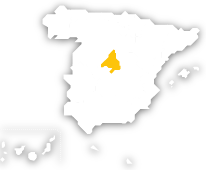
Within 100 kilometres of the city, Madrid has numerous options for enjoying nature all year round. These four plans are perfect for disconnecting from the pace of the city and spending a day in contact with nature in places such as the West Mountain range (Sierra Oeste) or the Sierra de Guadarrama National Park.
Debe activar Javascript para poder utilizar este servicio
-

4Charming mountain towns and villages
Torrelaguna, Patones, Buitrago de Lozoya and Rascafría are just some of the most popular towns and villages in Madrid’s North Mountain range (Sierra Norte). They bring you to the heart of nature and conserve their rural charm with narrow winding streets that lead onto the town’s main square, with houses built in the typical architecture, fantastic views of forests and the mountains, and in general, a wide-ranging gastronomy for enjoying Madrid’s most classical cuisine.The Sierra Norte forms part of the Sierra de Guadarrama National Park and these towns and villages are located at distances of between 65 and 100 kilometres from Madrid. One good option could be to visit at least two of them in one day, or combine the visits with a hiking route over a weekend, in places like the Lozoya or Angostura valleys.
-

4The beech forest of Madrid
This is the Hayedo de Montejo which forms part of the European beech forests that have been collectively declared a UNESCO World Heritage Site. It is particularly pretty in the autumn when it is ablaze with hues of russet, brown and orange, but travelling the paths and visiting the towns and villages, such as La Hiruela, Montejo de la Sierra, Horcajuelo de la Sierra, Prádena del Rincón and Puebla is a pleasant experience at any time of the year. Bear in mind that if you want to visit the beech forest you need to book in advance.
-

4Organised outdoor activities
The companies offering activities in the mountains of Madrid give you plenty of options to choose from. You could watch wild animals in their natural habitats, such as the wolf or the griffon vulture, or learn about the world of bees and honey-making by visiting bee farms. Or perhaps you would prefer to go horse or donkey riding, take part in cheese-making or baking workshops, try craft beer tasting or go mushroom picking in the mountains. You can even attend stargazing events at night or spend the day with a shepherd to learn about their work with goats. Information is available directly at each visitor centre, in the tourist offices or through the Madrid Region Tourist Board.
-

4The most popular hiking routes
There are many signposted paths in the Region of Madrid, such as the natural tracks, the Greenways (old disused railway lines that have been recovered and reconditioned into cycling or hiking paths), the hiking path network, the livestock trails (routes that are habitually used for grazing cattle). Consult the website for more information. These are some of the most popular routes: Route of Los chorros del Manzanares and La Charca Verde (also known as La Pedriza route): it is comfortable and goes around in a loop, which can be covered in under five hours. The route starts at Manzanares el Real and runs past the river for most of the journey. It includes several waterfalls and it’s easy to spot wildlife such as the mountain goat. This area is the gateway to the Sierra de Guadarrama National Park. The Water Route: starts in the municipality of Cercedilla, in the Sierra de Guadarrama mountain range. It is also a route suitable for people of all abilities as it is easy to cover and is around ten kilometres long (there and back). The best part are the views of the valley or La Fuenfría port. Canencia Ecological Trail: a comfortable, circular route of around two hours containing one of the region’s most popular outdoor leisure areas. Some highlights include the varied vegetation, the stop at La Chorrera de Mojonavalle waterfall and the views from the North Viewpoint. Peñalara Route: the Peñalara massif is the highest point of the region and its five-kilometre long trail is demanding. Along it you can see some of the best glacial remains of the Sierrade Guadarrama National Park. A good example is La Laguna Grande, which is very easy to access. What’s more, there are other routes close by which open up into singular landscapes. For example, in Valdepeñas de la Sierra (in Guadalajara, at least 90 kilometres from Madrid) is the Route of Las Cárcavas. These are curious red-coloured formations known as the fairy chimneys (strange natural columns formed from the erosion). Whereas, in Buendía (in Cuenca, 130 kilometres from Madrid) there is a unique route, and one that is loved by children. This is the Route of the Faces, known by this name because along the way you can see a series of surprising and different shaped faces sculpted into the surface of the rocks and gorges.









